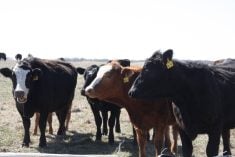This cattle market information is selected from the weekly report from Canfax, a division of the Canadian Cattlemen’s Association. More market information, analysis and statistics are available by becoming a Canfax subscriber by calling 403-275-5110 or at www.canfax.ca.
Fed cattle weak
There was not enough cash trade to establish a trend, but the market was weak, pressured by the stronger loonie and slow slaughter rates.
Alberta dressed sales and bids were $282-$287, which was $3-$8 lower than the previous week. Packers were not lifting cattle until the end of March.
Read Also

Why feds imposed EV tariffs
Moe and Kinew have a fight on their hands when it comes to eliminating the EV tariff. Canada has to worry about pissing off the U.S. and Mexico and hundreds of thousands of auto workers.
The Alberta cash to Chicago futures basis weakened to -$16 to -$20.
It appears neither Alberta federal plant operated Feb. 20, which lowered weekly slaughter to 31,000 head.
Canadian cash prices are near the lowest levels this year, and some producers are booking cattle into the United States while others are selling more cattle on grid pricing.
Carcasses remain large, but market-ready supply is manageable.
Yearling numbers should decline over the next month and the market has the potential to rally back to the upper $170s to low $180s.
U.S. cash trade developed only late on Friday with only a few dressed sales in the northern U.S. at steady to $2 higher.
The Chicago April live cattle contract traded at the highest level seen this year.
Slaughter cows steady
D1, D2 cows ranged $100-$114 to average $106.75 per cwt., and D 3 cows ranged $85-$100 to average $94.75. Dressed bids were $207-$212 per cwt. delivered.
Butcher bull prices rallied $2.64 to average $134.14 per cwt.
Western Canadian non-fed slaughter for the holiday week ending Feb. 20 fell 21 percent to 7,311 head.
Exports are 15 percent below a year ago. Supplies should tighten modestly, supporting prices.
Feeders mixed
Steer prices rose while heifers eased a little.
Stockers lighter than 400 pounds traded widely on varied lot size and quality, while improved grass interest pushed 400-700 lb. calf prices higher.
The 500 lb. steer-heifer calf price spread in February widened to more than $36 per cwt., which does not bode well for herd expansion.
Trade on feeders heavier than 700 lb. was uneven with discounts on fleshy cattle.
Weekly auction volume rose 31 percent, but was 11 percent smaller than last year at the same time.
Exports to Feb. 13 rebounded to 3,224 head, the best week since October, but exports are down 85 percent this year.
Auction volume should rise seasonally, peaking in mid-March.
Calf prices will likely follow the seasonally stronger trend.
Concerns for summer pasture moisture have weakened enthusiasm for middle weight feeders.
Mild weather is pushing yearling weights and body condition higher, and prices for feeders heavier than 900 lb. could dip.
Bred cows ranged $1,575-$3,025 and bred heifers ranged $2,200-$2,800.
U.S. beef rallies
U.S. boxed beef prices rose to Feb. 25 with Choice up US$5.37 at $218.76 and Select up $4.71 at $213.76.
Signs of an early spring in the U.S. have retailers stocking up on grilling items.
Weekly Canadian cut-out values to Feb. 20 traded lower with AAA down C$5.28 at $288.73 and AA down $13.41 at $281.72.














